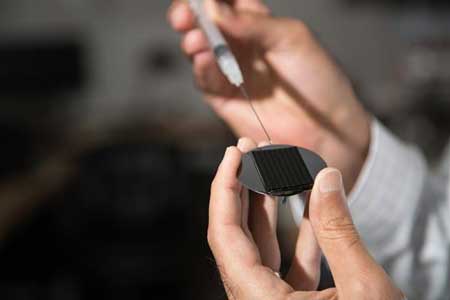| Posted: Nov 10, 2016 |
A 'magnetic slippery surface' improves de-icing
(Nanowerk News) Icy conditions can be deadly, whether you're flying into bad weather or too close to power transmission lines during a storm. Researchers at the University of Houston have reported the discovery of a material that can be applied to any surface to repel ice.
|
|
The material, known as a magnetic slippery surface (MAGSS) is described in the current issue of Nature Communications ("Magnetic slippery extreme icephobic surfaces").
|
 |
| Hadi Ghasemi illustrates how a drop of water rolls off his icephobic surface.
|
|
Hadi Ghasemi, Bill D. Cook Assistant Professor of mechanical engineering at UH and principal investigator for the research, said the material outperforms all others currently in use.
|
|
"Anti-icing surfaces have a critical footprint on daily lives of humans ranging from transportation systems and infrastructure to energy systems, but creation of these surfaces for low temperatures remains elusive," the researchers wrote. "Non-wetting surfaces and liquid-infused surfaces have inspired routes for the development of icephobic surfaces. However, high freezing temperature, high ice adhesion strength, and high cost have restricted their practical applications."
|
|
Ghasemi describes the material this way: One side of the surface is coated with a magnetic material, while a thin layer of magnetic fluid - a mixture of fluid and iron oxide nanoparticles - is deposited on the other side. The magnetic fluid faces outside. When a droplet of water hits the surface, the magnetic fluid acts as a barrier, stopping the droplet from reaching the solid surface.
|
|
"There's no adhesion of the ice to the solid surface, so it basically slides off the surface," he said.
|
|
Four of his students are listed as co-authors: Peyman Irajizad, Nazanin Farokhnia, Seyed Mohammad Sajadi and Munib Hasnain.
|
|
Potential applications range from the aircraft industry - planes can encounter freezing rain or super-cooled water droplets while flying, leading to a buildup of ice and potentially, a crash - to the power industry, where icing can cause power poles, towers and transmission lines to collapse.
|
|
Ultimately, Ghasemi hopes to develop the coating as a spray that can be applied to any surface. He has a patent pending on the discovery.
|
|
"These surfaces (MAGSS) provide a defect-free surface for ice nucleation and thereby lower the ice formation to close to homogenous nucleation limit," the researchers wrote. "These surfaces promise a new paradigm for development of icephobic surfaces in aviation technologies, ocean-going vessels, power transmission lines and wind turbines in extreme environments."
|
|
Among the advantages of the new material, Ghasemi said, is that it has a far lower freezing threshold than the best icephobic technology currently available - about minus 29 degrees Fahrenheit, compared to minus 13 degrees Fahrenheit for current technology.
|
|
"These new surfaces provide the path to tackle the challenge of icing in systems, thereby improving the quality of human life," he said.
|

